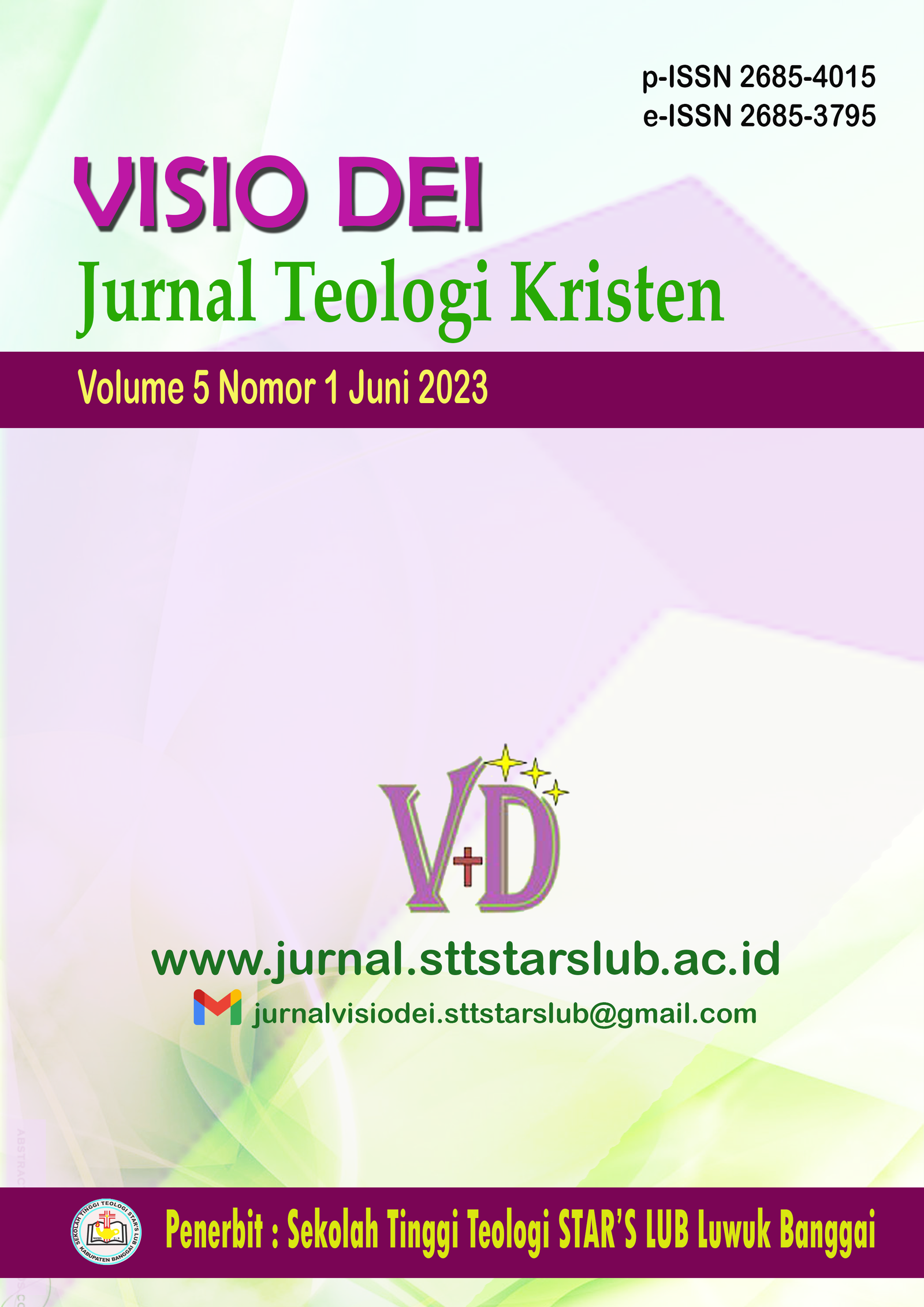Contextualization of the Concept of Human Salvation in the Bible for Adherents of the Aluk To Dolo
Abstract
The Gospel of salvation must be conveyed to all people so that they believe and accept Jesus as the only savior. To carry out this mission, a contextual way of theology is needed, including using the culture of the prospective recipient of the Gospel. Within the Toraja community in the province of South Sulawesi, some still adhere to the Aluk To Dolo belief. They have a mythology about creation and humanity's fall into sin, similar to similar stories in the Bible. This research wants to know whether this mythology can be a medium to preach the Gospel of salvation in Jesus Christ to Aluk To Dolo adherents. The research method used is a literature study. The data is taken from various literature; mainly the research results on the mythology of Aluk To Dolo. The research results obtained from a comparison between the Aluk To Dolo mythology and the Bible story about the creation and fall of humans show that the human intermediary with God in the Aluk To Dolo mythology failed to save humans, but Jesus succeeded. Therefore, Jesus is the only savior for humanity. Everyone who believes in Jesus will return to God. Thus, the Aluk To Dolo mythology about the creation and fall of humans into sin can be an effective medium for preaching the Gospel of salvation to Aluk To Dolo adherents.
Downloads
References
Adams, D. J. (2006). Teologi Lintas Budaya Refleksi Barat di Asia. BPK Gunung Mulia.
Anggraeni, A. S., & Putri, G. A. (2021). Makna Upacara Adat Pemakaman Rambu Solo’ di Tana Toraja. Visual Heritage: Jurnal Kreasi Seni dan Budaya, 3(1), 72–81. https://doi.org/10.30998/vh.v3i1.920
Barker, K. L. (2015). A Biblical Theologi of The Old Testament. Gandum Mas.
Baskoro, P. K. (2021). Tinjauan Teologis Konsep Keselamatan Menurut Roma 10:9 dan Implikasinya Bagi Penginjilan Masa Kini. Jurnal Teologi (JUTEOLOG), 2(1), 60–77. https://doi.org/10.52489/juteolog.v2i1.39
Becker, T. D. (2009). Pedoman Dogmatika: Suatu Kompendium Singkat. BPK Gunung Mulia.
Berkhof, L. (2020). Teologi Sistematika Doktrin Manusia. Momentum.
Dominggus, D. (2019). Kemanunggalan dalam Yohanes 15:7 Sebagai Misi Kontekstual Kepada Penganut Kejawen. Visio Dei: Jurnal Teologi Kristen, 1(2), 178–199. https://doi.org/10.35909/visiodei.v1i2.53
Erickson, M. J. (2015). Teologi Kristen Volume Dua. Gandum Mas.
Haryono, T., & Attilovita, A. (2021). Model Komunikasi Kabar Keselamatan Kepada Aluk To Dolo Di Tana Toraja. Fidei: Jurnal Teologi Sistematika dan Praktika, 4(1), 60–77. https://doi.org/10.34081/fidei.v4i1.126
Hessegrave, D. J., & Rommen, E. (2006). Kontekstualisasi Makna, Metode, dan Model. BPK Gunung Mulia.
Ismail, R. (2019). Ritual Kematian Dalam Agama Asli Toraja “Aluk To Dolo” (Studi Atas Upacara Kematian Rambu Solok). Religi: Jurnal Studi Agama-Agama, 15(1), 87–106. https://doi.org/10.14421/rejusta.2019.1501-06
Kristanto, & Mangolo, Y. (2018). Aluk To Dolo Versus Kristen. Kinaa: Jurnal Teologi, 3(1), 1–10. https://doi.org/10.0302/kinaa.v3i2.457
Manafe, D. S., Morib, T., & Pelamonia, R. (2022). Kontekstualisasi Misi Terhadap Budaya Bakar Batu Suku Lani dan Implementasinya bagi Gereja Injili di Indonesia (GIDI) Jemaat Jigunikime Puncak Jaya Papua. Makarios: Jurnal Teologi Kontekstual, 1(1), 97–122. https://doi.org/10.52157/mak.v1i1.170
Nainggolan, A. M. (2021). Refleksi Teologis Kepastian Keselamatan. Pengarah: Jurnal Teologi Kristen, 3(2), 137–153. https://doi.org/10.36270/pengarah.v3i2.66
Nainggolan, A. M. (2023). Memahami Kepastian Keselamatan Dari Masa Ke Masa: Sebuah Kajian Historis dan Teologis. Feniks Muda Sejahtera.
Nazir, M. (2003). Metode Penelitian. Ghalia Indonesia.
Panuntun, D. F. (2020). Nilai Hospitalitas Dalam Budaya Longko’Torayan. In Teologi Kontekstual Dan Kearifan Lokal Toraja. BPK Gunung Mulia.
Patora, M. (2021). Agama dan Pelestarian Budaya: Sebuah kajian Alkitab terhadap Praktik Aluk Rambu Solo’dalam Upacara Kematian orang Kristen Toraja. EPIGRAPHE: Jurnal Teologi dan Pelayanan Kristiani, 5(2), 221–229. https://doi.org/10.33991/epigraphe.v5i2.296
Putirulan, D. G. S. (2015). Studi Teologi Kontekstual terhadap Dasar Teologi Pola Induk Pelayanan dan Rencana Induk Pemgembangan Pelayannan (PIP-RIPP) GPM Tahun 2005-2015 [Program Studi Teologi FTEO-UKSW]. https://repository.uksw.edu//handle/123456789/12284
Rahayu, W. (2017). Tongkonan: Mahakarya Arsitektur Suku Toraja. Badan Pengembangan dan Pembinaan Bahasa. http://repositori.kemdikbud.go.id/id/eprint/5527
Ryrie, C. C. (1991). Teologi Dasar 1. ANDI Offset.
Schreiter, R. J. (2006). Rancang Bangun Teologi Lokal. BPK Gunung Mulia.
Stekom. (n.d.). Aluk To Dolo. In Ensiklopedia Dunia. Universitas Sains dan Teknologi Komputer. https://p2k.stekom.ac.id/ensiklopedia/Aluk_Todolo
Sulselprov. (n.d.). Kabupaten Toraja Utara. https://sulselprov.go.id/pages/des_kab/20
Tolan, F. M. (2016). Keragaman Makna di Balik Sepu’ bagi Orang Toraja di Salatiga: Analisa Semiotika Roland Barthes [Fiskom Universitas Kristen Satya Wacana Salatiga]. https://repository.uksw.edu/handle/123456789/11705
Copyright (c) 2023 Delpi Novianti, Alon Mandimpu Nainggolan, Patresia Rante Tumba

This work is licensed under a Creative Commons Attribution-ShareAlike 4.0 International License.
Visio Dei: Jurnal Teologi Kristen publishes articles under the Creative Commons Attribution-ShareAlike 4.0 (CC BY-SA 4.0). Users are free to copy, modify, or redistribute articles for any lawful purpose in any media, provided they give appropriate credit to the original author and Visio Dei: Jurnal Teologi Kristen as the publisher, links to the license, indicate if changes have been made, and redistribute any derivative works under the same license.
Article copyright is held by the respective author (s), without limitation. A non-exclusive license is granted to Visio Dei: Jurnal Teologi Kristen to publish articles and identify itself as the original publisher, including commercial rights to sell them to libraries and individuals.
By publishing articles in Visio Dei: Jurnal Teologi Kristen, authors grant rights to third parties to use their articles to the extent granted by the Creative Commons Attribution-ShareAlike 4.0 International license.














